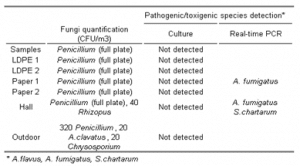Context
In the management of solid waste, pollutants over a wide range are released with different routes of exposure for workers. The potential for synergism among the pollutants raises concerns about potential adverse health effects, and there are still many uncertainties involved in exposure assessment.
In this study [1], molecular real-time polymerase chain reaction (RT-PCR) was used to assess the presence of three potential pathogenic/toxigenic fungal species: Aspergillus flavus, A. fumigatus, and Stachybotrys chartarum from air samples collected with a Coriolis µ in a waste-sorting plant. These results were compared with the cultivable fungal air contamination obtained by conventional method (culture-based).
Materials
- Coriolis μ, sterile cones, 10mL sterile phosphate-buffered saline with 0.005% TritonX100.
- Conventional method: Millipore air Tester (Millipore), sterile petri dishes, malt extract agar (MEA) with chloramphenicol (0.05%).
Protocol
- Sampling at five different workstations inside the facilities and also outdoors as a reference.
- Coriolis air sampling: 300L/min, 1min. Liquid air sample analyzed by RT-PCR (Specific primers and TaqMan probes were used to detect the presence of each specie by Real Time PCR in iQ Real Time Detection System (Bio-Rad)).
- Culture-based analysis (Conventional method): 50L collected by impaction method (140 L/min). Incubation of agar plates for 5 to 7 days at +27 ºC.
Results
Penicillium sp. were the most common species found at all plant locations by conventional methodology. Pathogenic/toxigenic species (A. fumigatus and S. chartarum) were detected at two different workstations by RT-PCR but not by culture-based techniques (Table 1).

Table 1: Characterization of the airbone fungi detected
Our results illustrated the advantage of combining both conventional and molecular methodologies in fungal exposure assessment.
Together with microbial volatile organic compounds (MVOC) analyses in indoor air, data obtained allow for a more precise evaluation of potential health risks associated with bioaerosol exposure. Consequently, with this knowledge, strategies may be developed for effective protection of the workers.
